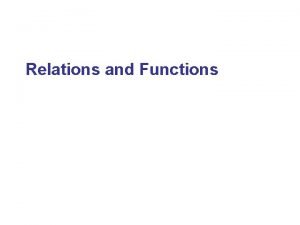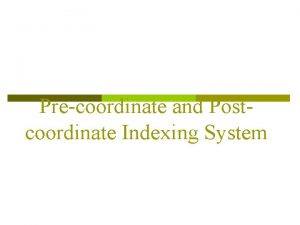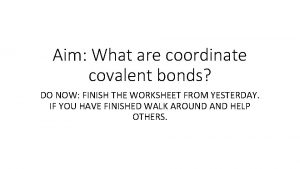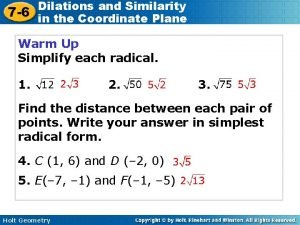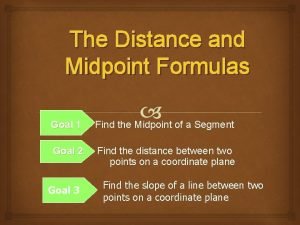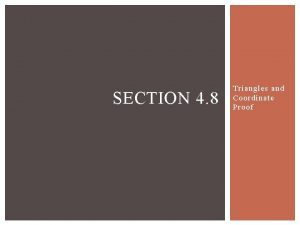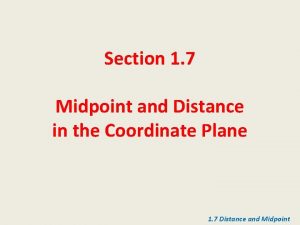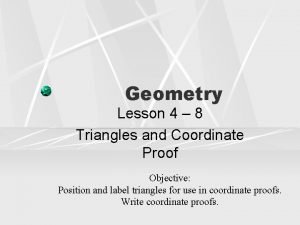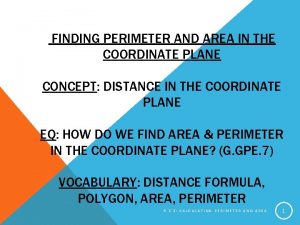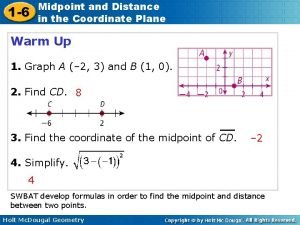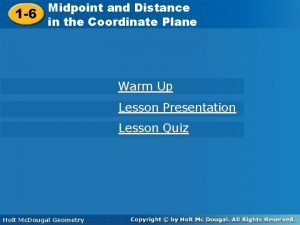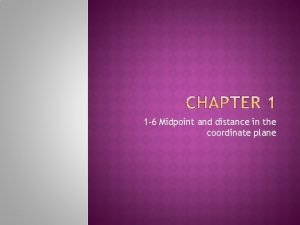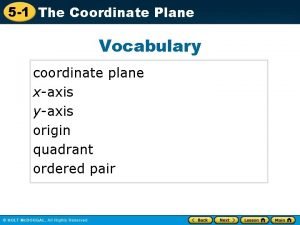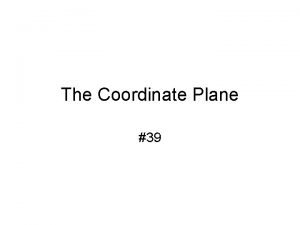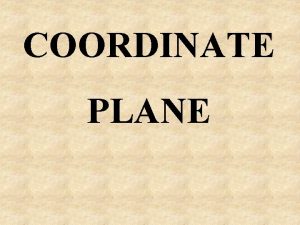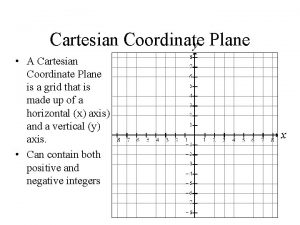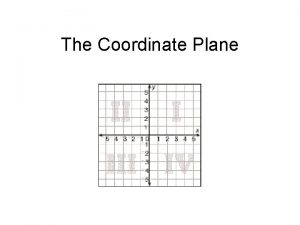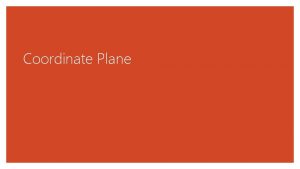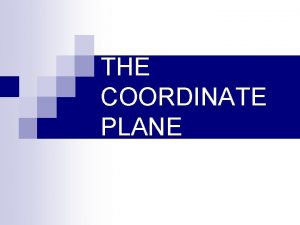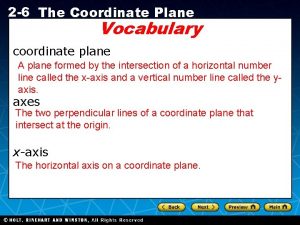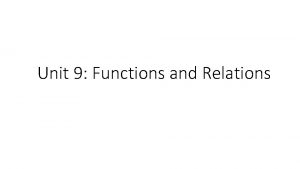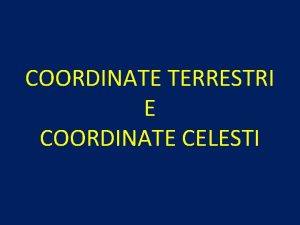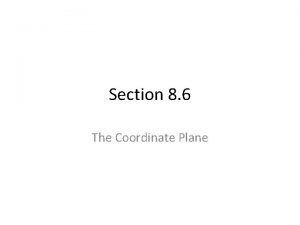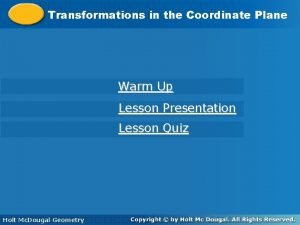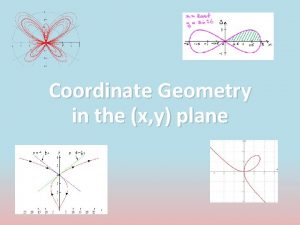Chapter 5 Review Relations and Functions Coordinate Plane
















- Slides: 16

Chapter 5 Review Relations and Functions

Coordinate Plane Label these: X Axis Y Axis Quadrant I Origin II IV

Coordinates are written (x, y) Which Quadrant is point N in? Point S?

Chapter 5 -2 Domain and Range Domain: all of the x values Range: all of the y values

Chapter 5 -2 Functions What is a function? A relation that assigns exactly one value in the range to each value in the domain I. E. Every X value has only one Y value 2 tests that can be used to see if a relation is a function: 1) For a list of ordered pairs, make sure there are no repeating X values 2) For a graph, use the Vertical Line Test

Is it a Function? Identify the Domain and the Range. Determine if the relation is a function {(-2, -1), (-1, 0), (6, 2), (6, 3), (2, 1)} {(6. 5, 0), (7, -1), (6, 2), (2, 6), (-6. 5, -1)}

Is it a Function?

Chapter 5 -2 Evaluating Functions Evaluate f(x) = 3 x -5 for x= -2 Evaluate f(b) = b 2 + 1 for b= 3

Chapter 5 -3 Graphing Functions Graph the following functions using and input/output table. 1. f(x) = - x + 4 x f(x) 2. f(x) = |x | + 4

Chapter 5 -3 Graphing Functions 3. f(x) = |x - 4| 4. f(x) = x 2 + 4

Chapter 5 -4 Writing Rules for Functions Step: 1. Find a pattern. Think, “how did they get from x to y? ” 2. Write an equation from the pattern. 3. Check the equation for a couple of domain values. 1. x 1 2 3 4 y 5 6 7 8 y=x+4 2. x 1 2 3 4 y 2 4 6 8 y = 2 x 3. x 1 3 f(x) 1 9 6 9 36 81 f(x) = x 2

Chapter 5 -4 Writing Rules for Functions Step: 1. Define your variables (2). 2. Write an equation according to the situation. 3. Check the equation. Write a function rule for each situation. The total cost t(c) of c ounces of cinnamon if each ounce costs $. 79 t(c) = total cost c = ounces t(c) = $. 79 c

Chapter 5 -4 Writing Rules for Functions Step: 1. Define your variables (2). 2. Write an equation according to the situation. 3. Check the equation. Write a function rule for each situation. The area A (n) of a square when you know the length n of a side. A(n) = area of sqaure n = length of side A (n) = n 2

Word Problem A donut costs 75 cents. a. Write a function rule to describe how the amount of money M needed to buy n number of donuts. b. Make a table of values showing how much it would cost to buy 4 different amounts of donuts c. Graph the function

Chapter 5 -6 Number Paterns Inductive reasoning: making conclusions based on patterns you observe. A number pattern is also called a sequence

Chapter 5 -6 Finding Common Difference What does “common difference” mean? how much to add to get to the next number
 Data plane control plane and management plane
Data plane control plane and management plane Relation vs function
Relation vs function Post coordinate indexing system
Post coordinate indexing system Timid bigot example
Timid bigot example Chapter 10 racial and ethnic relations review worksheet
Chapter 10 racial and ethnic relations review worksheet Coordinate covalent bond vs coordinate ionic
Coordinate covalent bond vs coordinate ionic Midpoint formula on a coordinate plane
Midpoint formula on a coordinate plane 7-6 dilations and similarity in the coordinate plane
7-6 dilations and similarity in the coordinate plane Dilations and similarity in the coordinate plane
Dilations and similarity in the coordinate plane Distance and midpoint formula
Distance and midpoint formula What proof uses figures
What proof uses figures 1-7 midpoint and distance in the coordinate plane
1-7 midpoint and distance in the coordinate plane 4-8 skills practice triangles and coordinate proof
4-8 skills practice triangles and coordinate proof Perimeter on coordinate plane
Perimeter on coordinate plane Distance and midpoint exploration
Distance and midpoint exploration 5-1 midpoint and distance in the coordinate plane
5-1 midpoint and distance in the coordinate plane Midpoint and distance in the coordinate plane worksheet
Midpoint and distance in the coordinate plane worksheet

